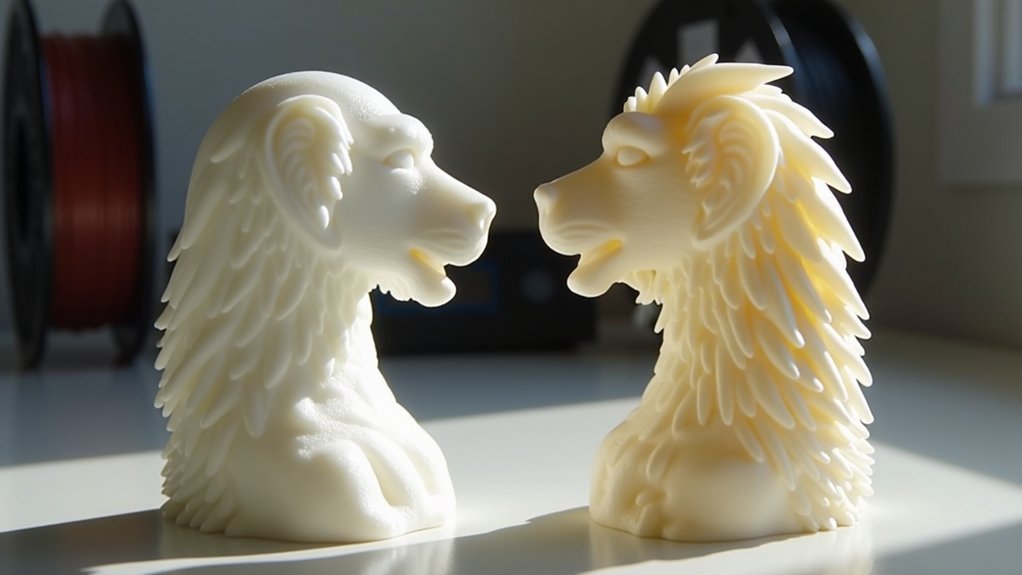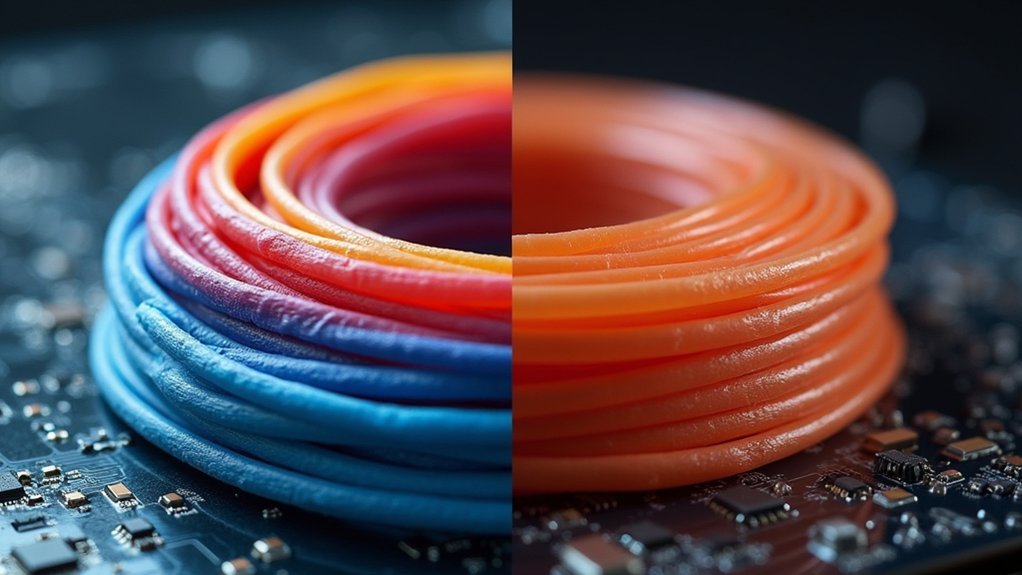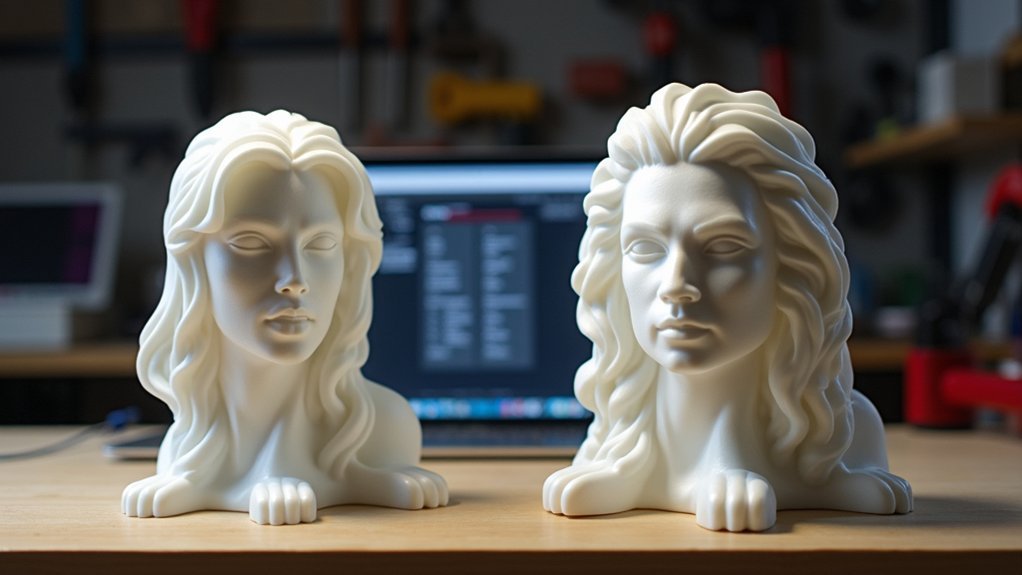You’ll get cleaner prints with firmware retraction since it allows real-time adjustments during printing, while slicer settings remain static throughout the entire job. Firmware retraction typically uses shorter distances (0.5-1mm) and speeds of 40-50mm/s, compared to slicer settings requiring 1-2mm distances at up to 60mm/s. Empirical tests show firmware retraction adapts better to varying conditions, producing smoother surfaces and superior layer bonding. Understanding the setup process for both methods will help you optimize your specific printing environment.
Understanding Retraction Fundamentals in 3D Printing

When your 3D printer moves between different areas of a print without extruding material, retraction becomes your primary defense against stringing and oozing. This critical process pulls filament back into the nozzle during travel moves, preventing unwanted material from dripping onto your print surface.
You’ll encounter retraction settings in both your slicer software and printer firmware. Traditional slicers let you adjust parameters like retraction length and speed, giving you control over how much filament gets pulled back and how quickly it happens.
Meanwhile, firmware retraction uses G10 and G11 G-codes, offering real-time adjustments without reslicing your model. Proper retraction configuration dramatically improves print quality by eliminating those unsightly filament trails that can ruin your project’s appearance.
Traditional Slicer Retraction Parameters and Controls
You’ll find that traditional slicer retraction controls center around two fundamental parameters: retraction distance and retraction speed.
Your retraction distance typically ranges from 0.5mm to 2mm depending on your material and printer setup, while retraction speed usually falls between 25mm/s and 70mm/s.
These core settings work together to determine how effectively your printer pulls back filament during travel moves, directly impacting print quality and stringing control.
Core Retraction Settings
Although firmware handles the mechanical execution of retraction, your slicer’s retraction parameters serve as the primary control interface for managing filament behavior during travel moves. When retraction enabled is activated, you’ll need to configure several core settings for ideal results.
Retraction distance determines how far your filament pulls back before travel moves, typically ranging from 1mm to 6mm depending on your material and printer setup.
Retraction speed controls the pullback rate, commonly set between 25mm/s to 100mm/s, directly affecting print quality and stringing prevention.
Additional settings include unretract distance and speed, allowing material-specific customization.
Z-hop lifts your nozzle 0.2mm to 1mm during travels, preventing collisions with existing prints.
You’ll need to test and fine-tune these parameters through trial and error since ideal configurations vary considerably based on your printer type, filament, and specific designs.
Speed and Distance Control
Since successful retraction depends heavily on precise parameter tuning, understanding the relationship between speed and distance settings becomes essential for achieving clean prints. Your retraction length typically ranges from 0.5mm to 2.5mm, depending on your printer and filament combination. Speed settings between 20mm/s and 50mm/s directly impact stringing quality, with slower speeds often producing superior results despite longer print times.
| Parameter | Range | Impact |
|---|---|---|
| Retraction Length | 0.5-2.5mm | Controls filament pullback distance |
| Retraction Speed | 20-50mm/s | Affects stringing and print time |
| Z-hop Height | 0.1-0.3mm | Prevents nozzle collisions |
You’ll need to test different combinations systematically, adjusting unretract distances to fine-tune how much filament returns to the nozzle. Material properties greatly influence ideal settings.
Firmware Retraction Technology Overview

When your 3D printer receives G10 and G11 G-codes, it handles filament retraction and unretraction through firmware-level commands rather than the traditional method of explicit extruder movements generated by your slicer.
This firmware retraction technology shifts control from slicer-generated settings to your printer’s firmware, enabling real-time parameter adjustments without re-slicing models.
You’ll need to configure firmware retraction differently depending on your system. Marlin users must uncomment `define FW_RETRACT` in configuration settings, while Klipper requires adding a `firmware_retraction` section to your config file.
Typical parameters include 1mm retraction at 40mm/s speed.
The key advantage lies in flexibility—you can adjust retraction distance and speed mid-print based on observed quality issues, making it particularly valuable for print farms managing multiple materials.
Setting Up Firmware Retraction in Marlin
Before you can harness Marlin’s firmware retraction capabilities, you’ll need to modify your printer’s configuration file by uncommenting the `#define FW_RETRACT` line. This enables your hot end to recognize firmware retraction commands.
Once enabled, configure your retraction parameters using the M207 command. A typical setup involves 1mm retraction at 40mm/s, though you’ll adjust these values based on your specific hot end and filament requirements.
Configure retraction with M207 using 1mm at 40mm/s as starting values, then adjust for your specific setup.
Use the M208 command to fine-tune unretract settings for precise filament control.
Don’t forget to modify your slicer settings to generate G10 and G11 commands in your G-code files. Without these commands, firmware retraction won’t function.
Test your setup by printing models with travel moves, observing for stringing or oozing issues to verify effectiveness.
Configuring Firmware Retraction in Klipper

Klipper’s firmware retraction configuration requires adding a `[firmware_retraction]` section to your printer’s configuration file, which enables dynamic retraction control during prints. You’ll need to specify parameters like retract_length (typically 1mm) and retract_speed (around 40mm/s) within this section.
| Parameter | Value | Description |
|---|---|---|
| retract_length | 1.0 | Distance in mm |
| retract_speed | 40 | Speed in mm/s |
| unretract_extra_length | 0.0 | Additional unretract |
| unretract_speed | 40 | Unretract speed |
| retract_lift_z | 0.0 | Z-hop distance |
Configure your slicer to use G10/G11 commands instead of traditional retraction. After setup, test that your G-code includes these commands. Klipper’s firmware retraction lets you adjust settings mid-print without re-slicing, providing real-time optimization for print quality.
RepRap Firmware Retraction Implementation
RepRap firmware offers a similar approach to dynamic retraction control through the M207 command, which sets retraction parameters directly in the firmware rather than relying on slicer-generated values.
RepRap firmware’s M207 command enables direct firmware control of retraction parameters, bypassing traditional slicer-based retraction settings for enhanced precision.
You’ll need to include this command in your configuration file and adjust your slicer settings to support G10 and G11 G-code commands for retracting and unretracting filament.
The firmware retraction system lets you customize parameters like retraction length and speed, giving you precise control over the process.
You can conduct retraction tests during prints to make real-time adjustments for better results.
RepRap firmware’s G-code compatibility means you’ll retain existing slicer profiles while gaining advanced firmware retraction capabilities for improved print quality.
Slicer Configuration for Firmware Retraction
Once you’ve enabled firmware retraction in your printer’s firmware, you’ll need to configure your slicer to output the proper G-code commands that communicate with this feature.
You must verify your slicer supports G10 and G11 commands by adjusting the printer settings accordingly. These commands replace the standard extruder movements that typical slicers generate for retraction.
In your slicer’s retraction settings, set typical values like 1mm retraction length at 40mm/s speed.
However, consider making your unretract distance shorter and slower for peak performance.
Most modern slicers like PrusaSlicer, Cura, and others include firmware retraction options in their printer settings.
After configuration, test and tweak these settings to achieve significant improvements in print quality, particularly for reducing stringing while enhancing efficiency.
Parameter Tuning: Length and Speed Comparisons
When comparing firmware and slicer retraction performance, you’ll find that ideal parameter settings vary considerably between the two approaches.
Your retraction length requirements differ greatly – firmware retraction typically performs better with shorter distances of 0.5-1mm, while slicer settings often need 1-2mm for comparable results. This difference stems from firmware’s more precise timing control.
Your retraction speed settings also require adjustment between methods. Firmware retraction achieves best results at 40-50mm/s, whereas slicer-based retraction may need speeds up to 60mm/s to match performance.
You’ll notice firmware retraction provides more consistent results across different materials, reducing the need for frequent parameter adjustments. Testing both approaches with identical models reveals firmware retraction’s superior consistency in preventing stringing while maintaining smoother extrusion quality.
Z-Hop Functionality in Both Systems
When you’re setting up Z-hop, you’ll find significant differences between traditional slicer controls and firmware-based systems.
Traditional slicers give you straightforward parameter adjustment where you can easily set lift heights and enable Z-hop for travel moves.
However, firmware retraction in Klipper currently doesn’t support Z-hop functionality, creating limitations you’ll need to work around.
Traditional Z-Hop Settings
Although both firmware and slicer systems handle retraction, their approaches to Z-hop functionality reveal significant differences in capability and control.
Traditional slicer settings give you extensive Z-hop control, letting you enable lift movements during travel moves and adjust height precisely—typically around 0.2mm. You can activate or deactivate this feature based on your print’s specific requirements, with some slicers offering enhanced control over lift speed and timing.
However, firmware retraction systems like Klipper don’t currently support Z-hop functionality, creating a notable limitation compared to slicer-based approaches.
When you use traditional slicer settings with properly configured Z-hop, you’ll often see improved print quality through reduced stringing and fewer surface imperfections compared to prints without this feature enabled.
Firmware Z-Hop Limitations
While traditional slicers excel at Z-hop implementation, firmware retraction systems face significant limitations that can impact your printing decisions.
Currently, Klipper’s firmware retraction doesn’t support Z-hop functionality, forcing you to rely solely on retraction distance and speed for stringing prevention. This creates a significant disadvantage compared to slicer-based solutions like Cura and Simplified 3D, which seamlessly integrate Z-hop settings into their retraction processes.
Without firmware z-hop limitations being addressed, you’ll miss critical nozzle height control during travel moves. This absence becomes particularly problematic when printing complex geometries where collision avoidance is essential for high quality results.
You’ll need to implement alternative anti-stringing strategies or accept potentially reduced print quality when using firmware retraction exclusively.
Real-Time Adjustability Advantages
Since firmware retraction stores settings directly in your printer’s memory rather than embedding them in G-code, you can modify retraction parameters like distance and speed while your print runs.
This real-time adjustability eliminates the need to re-slice models when print quality issues arise, saving significant time and boosting efficiency.
You’ll find this particularly valuable in print farms where multiple printers require different settings for varying materials or environmental conditions.
The ability to conduct retraction tests during any active print provides immediate feedback for optimization.
Additionally, firmware retraction streamlines multi-extruder setups by allowing a single slicer profile to manage different hot ends, enhancing operational flexibility while maintaining consistent print quality across your entire printing operation.
Compatibility Limitations and Restrictions
You’ll encounter slicer software conflicts when using firmware retraction, as programs like Cura and Simplified 3D don’t always play nicely with firmware-controlled settings.
Hardware support gaps create another hurdle, since some Marlin printers lack the necessary firmware features due to unavailable source code.
These compatibility issues can force you to choose between your preferred slicer or accessing firmware retraction benefits.
Slicer Software Conflicts
Even though firmware retraction offers significant advantages, compatibility conflicts with your slicer software can create frustrating roadblocks that limit functionality.
When you’re going to set up firmware retraction, you’ll discover that slicer software conflicts emerge from differences in G-code generation between programs like Cura and Simplify3D. These slicers don’t always recognize firmware retraction commands properly, causing print quality issues.
Your Marlin-based printer might lack essential firmware support if the source code isn’t updated or available. Klipper users face additional restrictions since Z-hop functionality remains unsupported, limiting print quality enhancements.
Without compatible management tools like OctoPrint, configuring firmware retraction becomes cumbersome across different slicers, making it difficult to maintain consistent settings and peak performance.
Hardware Support Gaps
Beyond software compatibility issues, hardware limitations create even more significant barriers to implementing firmware retraction effectively.
You’ll find that older 3D printers often lack the updated firmware necessary for proper retraction support, leaving you stuck with outdated source code limitations. If you’re going to enable firmware retraction, you need to verify your control board and firmware version can handle the specific configuration requirements.
Klipper users face particular challenges since Z-hop functionality isn’t supported, forcing you to adapt your retraction strategy.
Many printers require additional tools like OctoPrint to manage firmware retraction settings properly. These hardware restrictions mean you can’t simply assume your printer will work seamlessly with firmware-based retraction, regardless of your slicer choice.
Multi-Extruder Management Differences
When working with multiple extruders, firmware retraction offers significant advantages over traditional slicer-based approaches. You’re going to use a single profile to control all hot ends simultaneously, eliminating the need for separate configurations per extruder. This streamlines your workflow and reduces configuration errors during multi-material prints.
| Feature | Firmware Retraction | Slicer Settings |
|---|---|---|
| Profile Management | Single unified profile | Separate per extruder |
| Mid-print Adjustments | Dynamic parameter changes | Fixed until re-slice |
| Print Farm Consistency | Uniform across printers | Varies by configuration |
| Filament Switching | Real-time optimization | Pre-configured only |
You’ll appreciate the flexibility of adjusting parameters dynamically mid-print when switching between filaments or colors. Print farms benefit from maintaining consistent retraction settings across multiple printers, ensuring uniform quality without complex slicer management.
Print Quality Impact Assessment
You’ll notice significant differences in print quality when comparing firmware retraction to slicer-based settings, particularly in how each approach handles stringing during travel moves.
Your layer adhesion can vary between methods since firmware retraction allows real-time adjustments that respond to changing print conditions, while slicer settings remain static throughout the job.
The surface finish quality you achieve depends largely on how well each system manages filament flow control and oozing prevention during critical printing phases.
Stringing and Travel Moves
Although both firmware and slicer-based retraction settings can combat stringing, understanding their distinct advantages helps you choose the most effective approach for your specific printing scenarios.
Firmware retraction offers real-time adjustments during prints, letting you fine-tune parameters without stopping mid-print. However, slicer-based settings provide more precise control over travel moves and Z-hop configurations.
You’ll typically want retraction lengths of 1-2 mm with speeds around 40-60 mm/s, regardless of your chosen method.
Enable Z-hop during travel moves to lift your nozzle slightly, preventing it from dragging across printed surfaces. This combination effectively reduces those unwanted threads between sections.
Regular testing remains essential—experiment with both firmware and slicer approaches to determine which delivers cleaner results for your specific materials and printing conditions.
Layer Adhesion Differences
Beyond preventing stringing, your retraction settings directly impact how well each layer bonds to the next, ultimately determining your print’s structural integrity. When you’re printing complex geometries, firmware retraction gives you real-time control that adapts to varying speeds and conditions, while slicer settings lock you into fixed parameters throughout the entire print.
| Retraction Method | Layer Adhesion Quality | Control Level |
|---|---|---|
| Firmware | Excellent adaptation | Real-time precision |
| Slicer | Consistent but rigid | Static parameters |
Your retraction speed and length affect filament cooling and solidification timing, which directly influences layer adhesion. Empirical tests consistently show firmware retraction achieving superior bonding in complex prints because it responds to actual printing conditions rather than predetermined assumptions.
Surface Finish Quality
When surface imperfections like stringing, oozing, and visible layer shifts plague your prints, the choice between firmware and slicer retraction settings becomes critical for achieving professional-grade results.
You’ll find that firmware retraction offers superior print quality through real-time adjustments that respond to specific issues as they develop. While slicer settings provide a solid foundation, they can’t adapt mid-print when quality problems emerge.
Tests consistently show firmware retraction produces smoother surfaces with fewer visible artifacts compared to static slicer configurations.
You can fine-tune retraction speeds and distances through firmware to eliminate surface imperfections caused by insufficient or excessive retraction.
Community feedback confirms users experience fewer print failures and significantly improved surface quality, especially when switching between different filament types using firmware-controlled retraction parameters.
Best Practices for Choosing the Right Method
Since choosing between firmware and slicer retraction settings can greatly impact your print quality, you’ll need to evaluate your specific project requirements before committing to either method.
Here’s your systematic approach for selecting the right retraction method:
- Test compatibility first – Verify your firmware supports advanced retraction features, as not all versions offer this functionality with every slicer combination.
- Run comparison prints – Execute identical models using both methods to directly assess which produces cleaner results for your specific materials and printer setup.
- Monitor parameter differences – Track how retraction length and speed settings perform differently between firmware and slicer approaches, adjusting accordingly.
- Leverage community insights – Connect with experienced users who’ve tested both methods to understand real-world performance before getting your projects going.
Frequently Asked Questions
Does Firmware Retraction Increase Print Time Compared to Slicer Retraction?
You won’t see significant print time differences between firmware and slicer retraction. Both methods perform the same filament withdrawal and advance movements, so they’ll take nearly identical amounts of time.
Can Firmware Retraction Cause Extruder Motor Overheating During Long Prints?
You won’t experience extruder motor overheating from firmware retraction during long prints. Retraction movements are brief, low-power operations that don’t generate significant heat compared to continuous extrusion during normal printing.
Which Method Consumes More Printer Memory During Complex Multi-Part Prints?
You’ll find firmware retraction consumes more printer memory during complex multi-part prints because it stores retraction parameters in RAM, while slicer-generated G-code commands don’t require additional memory storage during execution.
Does Switching Between Methods Require Recalibrating Bed Leveling and Offsets?
You won’t need to recalibrate bed leveling when switching between firmware and slicer setting methods. Your physical printer setup remains unchanged, so existing offsets and calibrations stay valid throughout different approaches.
Can Firmware Retraction Damage Flexible Filaments More Than Slicer Settings?
You’ll find firmware retraction can damage flexible filaments more because it uses fixed, aggressive settings that don’t adjust for material properties, while slicer settings let you customize gentler parameters.





Leave a Reply